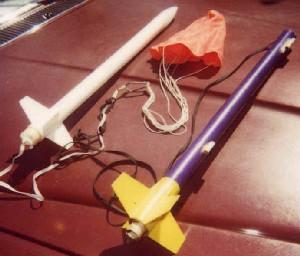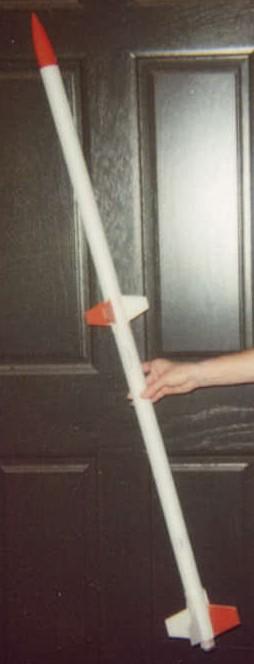 Brief:
Brief:
I originally designed Q4E as a simple, sturdy test bed for the new PerfectFlite
MicroAlt 4600 I bought to use in my NARTREK Gold projects. Q4E consists of a
Quest Falcon modified to fly as a payload compartment in place of the nose cone
on the Estes Eliminator.
Construction:
By stacking one kit atop another, a nifty "Sparrow" or
"AMRAAM"-type design results with plenty of room for a well-padded
altimeter. The resulting hybrid is now too heavy to fly on an E9, but it flies
well on a D12-5 or an E30-7 with a spacer in the 24mm motor mount.
The Falcon unit is constructed per the instructions, eliminating the motor mount and instead epoxying the Eliminator nose cone into the aft end of the Falcon fin can. The Eliminator unit is constructed normally, except that an additional 1/4" launch lug is glued to the hull 1.5" below the top of the tube, aligned with the original launch lug. Both are mounted on 1/4" scrap wood stand-offs with epoxy, so the launch wire clears the fin cans. The longer E-9 sized motor mount is used to preserve the option of flying with 24mm F21 motors, however, Q4E can NOT be flown with E9 motors, due to its 209g weight. The recovery system consists of an 18" LOC chute attached to 8' of para cord, anchored via a knot through the hull covered with half of a BIC pen cap and a gob of epoxy.
Flight:
As assembled and painted, and loaded with an E30-7 and a 21g PerfectFlite
altimeter, all-up weight is 275 gms, with CG at 31.125" and Cp at
33.875" from the nose, respectively. Q4E is thus 2 calibre stable and then
some. The MicroAlt is unmounted, and simply wrapped in a couple thicknesses of
Bounty-tm paper towels and lowered into the payload section, which is sealed
with masking tape. Five 1/32" vent holes were drilled into the
"Falcon" payload unit to provide atmospheric sampling for the
altimeter. Flight on the D12-5 was slow and stable in no-wind conditions, but
was susceptable to weathercocking in wind. Gain on this motor averaged 370'.
The E30-7 proved the ideal motor for Q4E, giving 1200' climbs (MicroAlt).
Recovery was perfect on the 18" chute arrangement.
Summary: PRO: Fast to build and sturdy. Flies on a variety of motors (D12-5, E30-7 to date, and simulations indicate that F21-8 and E18, E28 and F24 24mm reloads should work well also). Excellent as an altimeter test bed, with lots of room for the smaller units. Good looks.
CON: The extra set of fins provide extra drag, and the calculated Cd of 1.38 is pretty poor, performance-wise.
However, what you want here is to get your altimeter back in one piece, consistent with the design goal.
Other: Q4E is a robust, quick-building rocket that is reliable and fun to fly. I use it to test my altimeters before flying in fancier rockets, since Q4E has known performance on given motors. It has the good looks of an air-to-air missile like the Sparrrow.
Sponsored Ads
 |
 |











